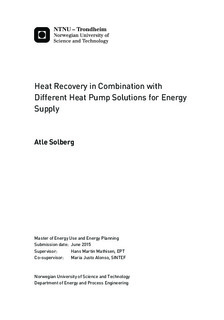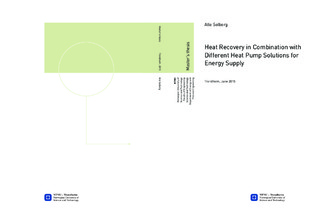| dc.description.abstract | The main purpose of this Master's thesis has been to investigate the performance of different methods of heat recovery from ventilation air. Comparisons have been made with regard to delivered energy for heating of domestic hot water, space heating and ventilation heating. A single-unit dwelling was used as a basis for the simulations. The house, built in accordance with the Norwegian passive house standard, had a gross internal area of 172.6 m². Seven different combinations of a heat wheel, an exhaust air CO₂ heat pump and an outdoor air CO₂ heat pump was assessed. Direct--acting electricity was used to cover the remaining heat demand in all seven heat recovery models. Three different occupant behaviour models and three different climates (Oslo, Stavanger and Kautokeino) were investigated in order to increase the area of application for the results. The building was simulated in IDA Indoor Climate and Energy, while the heat pump performance was post-processed in Matlab. Several aspects concerning heat recovery, dimensioning, ventilation and heating schedules, heat distribution, etc., have been assessed.
Simulations performed for a family of five with a high consumption of domestic hot water in Oslo showed that the required amount of delivered energy for heating was equal to 115 kWh/m²yr, without any heat recovery. The most used heat recovery method in Norway today, a heat wheel, reduces the energy demand by 34%, down to 76 kWh/m²yr. The most efficient heat recovery model that was found in this report showed a reduction of delivered energy for heating of 68%, down to 36 kWh/m²yr. This heat recovery model consists of a heat wheel and a heat pump utilizing both ventilation exhaust air and outdoor air. The recommended solution for occupants with a high domestic hot water consumption, when economy is taken into account, is based on a heat wheel and an exhaust air CO₂ heat pump. The amount of delivered energy is reduced by 66%, down to 40 kWh/m²yr.
Any further work within this field should look into the choice of refrigerant, improvements on the heat pump model and the impact of different building sizes. A more in-depth investment analysis of the different heat recovery models, including the heat distribution system in the building, should also be assessed. | |

